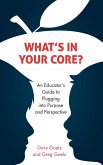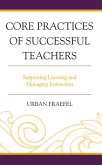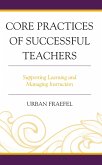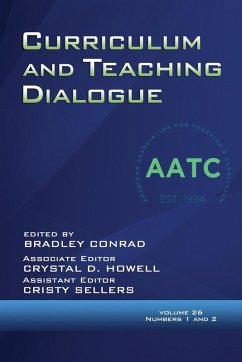- Broschiertes Buch
- Merkliste
- Auf die Merkliste
- Bewerten Bewerten
- Teilen
- Produkt teilen
- Produkterinnerung
- Produkterinnerung
Curriculum at Your Core is a practical guide to designing curriculum that meets standards, serves personal and institutional values, and intentionally leads to successful student learning.
Andere Kunden interessierten sich auch für
![Curriculum at Your Core Curriculum at Your Core]() Lauren PorosoffCurriculum at Your Core73,99 €
Lauren PorosoffCurriculum at Your Core73,99 €![What's in Your CORE? What's in Your CORE?]() Gary GoelzWhat's in Your CORE?85,99 €
Gary GoelzWhat's in Your CORE?85,99 €![What's in Your CORE? What's in Your CORE?]() Gary GoelzWhat's in Your CORE?46,99 €
Gary GoelzWhat's in Your CORE?46,99 €![Core Practices of Successful Teachers Core Practices of Successful Teachers]() Urban FraefelCore Practices of Successful Teachers107,99 €
Urban FraefelCore Practices of Successful Teachers107,99 €![Core Practices of Successful Teachers Core Practices of Successful Teachers]() Urban FraefelCore Practices of Successful Teachers48,99 €
Urban FraefelCore Practices of Successful Teachers48,99 €![Curriculum and Teaching Dialogue Volume 26, Numbers 1 & 2, 2024 Curriculum and Teaching Dialogue Volume 26, Numbers 1 & 2, 2024]() Curriculum and Teaching Dialogue Volume 26, Numbers 1 & 2, 202462,99 €
Curriculum and Teaching Dialogue Volume 26, Numbers 1 & 2, 202462,99 €![Lessons in School Improvement from Sub-Saharan Africa Lessons in School Improvement from Sub-Saharan Africa]() Miriam MasonLessons in School Improvement from Sub-Saharan Africa72,99 €
Miriam MasonLessons in School Improvement from Sub-Saharan Africa72,99 €-
-
-
Curriculum at Your Core is a practical guide to designing curriculum that meets standards, serves personal and institutional values, and intentionally leads to successful student learning.
Hinweis: Dieser Artikel kann nur an eine deutsche Lieferadresse ausgeliefert werden.
Hinweis: Dieser Artikel kann nur an eine deutsche Lieferadresse ausgeliefert werden.
Produktdetails
- Produktdetails
- Verlag: Rowman & Littlefield Publishers
- Seitenzahl: 164
- Erscheinungstermin: 8. Oktober 2014
- Englisch
- Abmessung: 254mm x 178mm x 9mm
- Gewicht: 322g
- ISBN-13: 9781475813111
- ISBN-10: 1475813112
- Artikelnr.: 41124062
- Herstellerkennzeichnung
- Libri GmbH
- Europaallee 1
- 36244 Bad Hersfeld
- gpsr@libri.de
- Verlag: Rowman & Littlefield Publishers
- Seitenzahl: 164
- Erscheinungstermin: 8. Oktober 2014
- Englisch
- Abmessung: 254mm x 178mm x 9mm
- Gewicht: 322g
- ISBN-13: 9781475813111
- ISBN-10: 1475813112
- Artikelnr.: 41124062
- Herstellerkennzeichnung
- Libri GmbH
- Europaallee 1
- 36244 Bad Hersfeld
- gpsr@libri.de
Lauren Porosoff has been a teacher for 14 years, has served as a diversity coordinator and a grade-level team leader, and has led a school-wide curriculum mapping initiative. She regularly supports teachers and administrators in crafting assignments, designing curriculum review processes, and planning professional development.
Curriculum at Your Core: Meaningful Teaching in the Age of Standards
Preface: The Values That Guided This Book Acknowledgments: The Evolution of
a Values-Congruent Book Introduction: Why Values? ·Curriculum That Serves
Multiple Sets of Values ·A Place at the Table: Your Values and the
Standards ·Using This Book Chapter 1: Clarifying the Values that Guide Your
Teaching oWhy Values? oWhat Values Are (and Aren't) oA Place at the Table:
Your Values and the Standards oClarifying Your Values as a Teacher oMaking
Values Statements oRendering Values from Academic Documents oAvoiding Your
Values oBarriers to Teaching By Your Values §Getting Stuck in Self-Limiting
Beliefs §Avoiding Uncomfortable Feelings §Disregarding What Matters Most
§External Factors oJust Noticing Chapter 2: Designing Curriculum Using
Multiple Sets of Values ·Teachers' Values vs. Students' Values ·Learning
What Your Students Value ·Teachers' Values vs. Other Teachers' Values
·Values Clarification for Groups ·Teachers' Values vs. Institutional Values
·Working with Institutional Values ·Accounting for Multiple Sets of Values
Chapter 3: Using Values to Focus Units ·The Unity of a Unit ·Ringmasters
and Drovers ·Making Titles Matter ·Essential or Valued? ·What Essential
Questions Sound Like ·From Values to Essential Questions Chapter 4:
Organizing Lessons in a Values-Congruent Unit oGathering oChoosing What to
Include -- and What to Let Go oBeginning a Unit with What's Familiar
oIntroducing New Material oChoosing Instructional Methods oCreating
Meaningful Contexts for Student Work §Projects §Cycles of Instruction,
Practice, and Application oRegularly Returning to What Matters oUsing the
Calendar oMaking a Lesson Calendar oMaking Adjustments Chapter 5:
Values-Congruent Assessments oKinds of Assessment Tasks o"Values-Dense"
Assessments oStudents Choosing How They're Assessed oWhen and How Often to
Give Assessments oHelping Students Reach Outcomes You Value §Provide
Multiple Models of Excellent Work for Students to Analyze §Teach All the
Skills Students Need to Do Well §Allow Class Time for Students to Reach
Your Expected Level of Quality §Modify Assignments to Fit Students' Needs
oWriting Assignment Guidelines §Consider What to Define and What to Leave
Open-Ended §Set Yourself Up to Give Values-Congruent Grades §Copy Valued
Expectations from Assignment to Assignment §Look for the Impact of
Unintended Bias oProject-Based Assessments and Values oAdjusting Some More
Chapter 6: Aligning a Unit oA Values-Aligned Unit oResistance to Alignment
oGetting Aligned oCommon Problems in Aligning a Unit §Problem: When the
Lessons and Assessment Don't Match the Essential Question §Problem: When
the Teacher Values Knowledge or Skills but Doesn't Explicitly Teach Them
§Problem: When the Assessment Task Measures What's Easy to Measure Instead
of the Valued Understandings §Problem: When Teachers Assume Students Will
Construct Valued Understandings for Themselves §Problem: When the Essential
Question Seems So Important That the Unit Goes On Too Long oAssessing Your
Unit Chapter 7: Designing a Values-Congruent Course oCourses as Heaps
oOngoing Strands oCourse-Level Essential Questions oDesigning a Meaningful
Assessment Mix oMore Factors in Creating an Assessment Mix §Media §Group
Size §Locations §Stakes oCharting an Assessment Mix oSequencing Your Course
§Creating Balance Between Competing Values §Building On Students' Existing
Knowledge and Skill Sets §Creating a Progression of Ideas §Upcycling
Student Work oThinking Flexibly About Sequence oAssessing Your Course
Chapter 8: Optimizing Your Students' Experience oGaps in the Curriculum
oMaking a Values Map of a Program oRepetitions in the Curriculum
oOptimizing the Curriculum oProgrammatic Assessment Mixes oRemoving
Barriers to Optimizing the Curriculum oValues Conflicts oIntegrating
Diverse Values §Writing Programmatic Essential Questions §Mapping Values in
the Program §Seeking Multiple Valued Practices Chapter 9: Connecting
Disciplines Using Values oFinding Connections oWhen Good Cross-Disciplinary
Efforts Go Bad oCross-Disciplinary Essential Questions oUsing
Cross-Disciplinary Essential Questions oOverly Broad Essential Questions
oTwo Kinds of Cross-Disciplinary Units oOrganizing a Multi-Class Unit
§Begin with a Shared Experience §Create a Multi-Class Project §Refer
Frequently to the Essential Question §Make an Adjustable Unit Calendar
oMulti-Class Assessments oGetting Colleagues Interested oOvercoming
Logistical Barriers oGoing for It Chapter 10: Increasing Values Congruence
Over Time ·The Evolution of a Values-Congruent Unit ·Unintended
Consequences ·Shifting Priorities ·Changing Times ·Action Research
·Critical Friends Groups ·Values-Congruent Professional Development
·Setting Goals ·Specific ·Meaningful ·Active ·Realistic ·Time-Limited ·The
Teacher You Want to Be Bibliography Index
Preface: The Values That Guided This Book Acknowledgments: The Evolution of
a Values-Congruent Book Introduction: Why Values? ·Curriculum That Serves
Multiple Sets of Values ·A Place at the Table: Your Values and the
Standards ·Using This Book Chapter 1: Clarifying the Values that Guide Your
Teaching oWhy Values? oWhat Values Are (and Aren't) oA Place at the Table:
Your Values and the Standards oClarifying Your Values as a Teacher oMaking
Values Statements oRendering Values from Academic Documents oAvoiding Your
Values oBarriers to Teaching By Your Values §Getting Stuck in Self-Limiting
Beliefs §Avoiding Uncomfortable Feelings §Disregarding What Matters Most
§External Factors oJust Noticing Chapter 2: Designing Curriculum Using
Multiple Sets of Values ·Teachers' Values vs. Students' Values ·Learning
What Your Students Value ·Teachers' Values vs. Other Teachers' Values
·Values Clarification for Groups ·Teachers' Values vs. Institutional Values
·Working with Institutional Values ·Accounting for Multiple Sets of Values
Chapter 3: Using Values to Focus Units ·The Unity of a Unit ·Ringmasters
and Drovers ·Making Titles Matter ·Essential or Valued? ·What Essential
Questions Sound Like ·From Values to Essential Questions Chapter 4:
Organizing Lessons in a Values-Congruent Unit oGathering oChoosing What to
Include -- and What to Let Go oBeginning a Unit with What's Familiar
oIntroducing New Material oChoosing Instructional Methods oCreating
Meaningful Contexts for Student Work §Projects §Cycles of Instruction,
Practice, and Application oRegularly Returning to What Matters oUsing the
Calendar oMaking a Lesson Calendar oMaking Adjustments Chapter 5:
Values-Congruent Assessments oKinds of Assessment Tasks o"Values-Dense"
Assessments oStudents Choosing How They're Assessed oWhen and How Often to
Give Assessments oHelping Students Reach Outcomes You Value §Provide
Multiple Models of Excellent Work for Students to Analyze §Teach All the
Skills Students Need to Do Well §Allow Class Time for Students to Reach
Your Expected Level of Quality §Modify Assignments to Fit Students' Needs
oWriting Assignment Guidelines §Consider What to Define and What to Leave
Open-Ended §Set Yourself Up to Give Values-Congruent Grades §Copy Valued
Expectations from Assignment to Assignment §Look for the Impact of
Unintended Bias oProject-Based Assessments and Values oAdjusting Some More
Chapter 6: Aligning a Unit oA Values-Aligned Unit oResistance to Alignment
oGetting Aligned oCommon Problems in Aligning a Unit §Problem: When the
Lessons and Assessment Don't Match the Essential Question §Problem: When
the Teacher Values Knowledge or Skills but Doesn't Explicitly Teach Them
§Problem: When the Assessment Task Measures What's Easy to Measure Instead
of the Valued Understandings §Problem: When Teachers Assume Students Will
Construct Valued Understandings for Themselves §Problem: When the Essential
Question Seems So Important That the Unit Goes On Too Long oAssessing Your
Unit Chapter 7: Designing a Values-Congruent Course oCourses as Heaps
oOngoing Strands oCourse-Level Essential Questions oDesigning a Meaningful
Assessment Mix oMore Factors in Creating an Assessment Mix §Media §Group
Size §Locations §Stakes oCharting an Assessment Mix oSequencing Your Course
§Creating Balance Between Competing Values §Building On Students' Existing
Knowledge and Skill Sets §Creating a Progression of Ideas §Upcycling
Student Work oThinking Flexibly About Sequence oAssessing Your Course
Chapter 8: Optimizing Your Students' Experience oGaps in the Curriculum
oMaking a Values Map of a Program oRepetitions in the Curriculum
oOptimizing the Curriculum oProgrammatic Assessment Mixes oRemoving
Barriers to Optimizing the Curriculum oValues Conflicts oIntegrating
Diverse Values §Writing Programmatic Essential Questions §Mapping Values in
the Program §Seeking Multiple Valued Practices Chapter 9: Connecting
Disciplines Using Values oFinding Connections oWhen Good Cross-Disciplinary
Efforts Go Bad oCross-Disciplinary Essential Questions oUsing
Cross-Disciplinary Essential Questions oOverly Broad Essential Questions
oTwo Kinds of Cross-Disciplinary Units oOrganizing a Multi-Class Unit
§Begin with a Shared Experience §Create a Multi-Class Project §Refer
Frequently to the Essential Question §Make an Adjustable Unit Calendar
oMulti-Class Assessments oGetting Colleagues Interested oOvercoming
Logistical Barriers oGoing for It Chapter 10: Increasing Values Congruence
Over Time ·The Evolution of a Values-Congruent Unit ·Unintended
Consequences ·Shifting Priorities ·Changing Times ·Action Research
·Critical Friends Groups ·Values-Congruent Professional Development
·Setting Goals ·Specific ·Meaningful ·Active ·Realistic ·Time-Limited ·The
Teacher You Want to Be Bibliography Index
Curriculum at Your Core: Meaningful Teaching in the Age of Standards
Preface: The Values That Guided This Book Acknowledgments: The Evolution of
a Values-Congruent Book Introduction: Why Values? ·Curriculum That Serves
Multiple Sets of Values ·A Place at the Table: Your Values and the
Standards ·Using This Book Chapter 1: Clarifying the Values that Guide Your
Teaching oWhy Values? oWhat Values Are (and Aren't) oA Place at the Table:
Your Values and the Standards oClarifying Your Values as a Teacher oMaking
Values Statements oRendering Values from Academic Documents oAvoiding Your
Values oBarriers to Teaching By Your Values §Getting Stuck in Self-Limiting
Beliefs §Avoiding Uncomfortable Feelings §Disregarding What Matters Most
§External Factors oJust Noticing Chapter 2: Designing Curriculum Using
Multiple Sets of Values ·Teachers' Values vs. Students' Values ·Learning
What Your Students Value ·Teachers' Values vs. Other Teachers' Values
·Values Clarification for Groups ·Teachers' Values vs. Institutional Values
·Working with Institutional Values ·Accounting for Multiple Sets of Values
Chapter 3: Using Values to Focus Units ·The Unity of a Unit ·Ringmasters
and Drovers ·Making Titles Matter ·Essential or Valued? ·What Essential
Questions Sound Like ·From Values to Essential Questions Chapter 4:
Organizing Lessons in a Values-Congruent Unit oGathering oChoosing What to
Include -- and What to Let Go oBeginning a Unit with What's Familiar
oIntroducing New Material oChoosing Instructional Methods oCreating
Meaningful Contexts for Student Work §Projects §Cycles of Instruction,
Practice, and Application oRegularly Returning to What Matters oUsing the
Calendar oMaking a Lesson Calendar oMaking Adjustments Chapter 5:
Values-Congruent Assessments oKinds of Assessment Tasks o"Values-Dense"
Assessments oStudents Choosing How They're Assessed oWhen and How Often to
Give Assessments oHelping Students Reach Outcomes You Value §Provide
Multiple Models of Excellent Work for Students to Analyze §Teach All the
Skills Students Need to Do Well §Allow Class Time for Students to Reach
Your Expected Level of Quality §Modify Assignments to Fit Students' Needs
oWriting Assignment Guidelines §Consider What to Define and What to Leave
Open-Ended §Set Yourself Up to Give Values-Congruent Grades §Copy Valued
Expectations from Assignment to Assignment §Look for the Impact of
Unintended Bias oProject-Based Assessments and Values oAdjusting Some More
Chapter 6: Aligning a Unit oA Values-Aligned Unit oResistance to Alignment
oGetting Aligned oCommon Problems in Aligning a Unit §Problem: When the
Lessons and Assessment Don't Match the Essential Question §Problem: When
the Teacher Values Knowledge or Skills but Doesn't Explicitly Teach Them
§Problem: When the Assessment Task Measures What's Easy to Measure Instead
of the Valued Understandings §Problem: When Teachers Assume Students Will
Construct Valued Understandings for Themselves §Problem: When the Essential
Question Seems So Important That the Unit Goes On Too Long oAssessing Your
Unit Chapter 7: Designing a Values-Congruent Course oCourses as Heaps
oOngoing Strands oCourse-Level Essential Questions oDesigning a Meaningful
Assessment Mix oMore Factors in Creating an Assessment Mix §Media §Group
Size §Locations §Stakes oCharting an Assessment Mix oSequencing Your Course
§Creating Balance Between Competing Values §Building On Students' Existing
Knowledge and Skill Sets §Creating a Progression of Ideas §Upcycling
Student Work oThinking Flexibly About Sequence oAssessing Your Course
Chapter 8: Optimizing Your Students' Experience oGaps in the Curriculum
oMaking a Values Map of a Program oRepetitions in the Curriculum
oOptimizing the Curriculum oProgrammatic Assessment Mixes oRemoving
Barriers to Optimizing the Curriculum oValues Conflicts oIntegrating
Diverse Values §Writing Programmatic Essential Questions §Mapping Values in
the Program §Seeking Multiple Valued Practices Chapter 9: Connecting
Disciplines Using Values oFinding Connections oWhen Good Cross-Disciplinary
Efforts Go Bad oCross-Disciplinary Essential Questions oUsing
Cross-Disciplinary Essential Questions oOverly Broad Essential Questions
oTwo Kinds of Cross-Disciplinary Units oOrganizing a Multi-Class Unit
§Begin with a Shared Experience §Create a Multi-Class Project §Refer
Frequently to the Essential Question §Make an Adjustable Unit Calendar
oMulti-Class Assessments oGetting Colleagues Interested oOvercoming
Logistical Barriers oGoing for It Chapter 10: Increasing Values Congruence
Over Time ·The Evolution of a Values-Congruent Unit ·Unintended
Consequences ·Shifting Priorities ·Changing Times ·Action Research
·Critical Friends Groups ·Values-Congruent Professional Development
·Setting Goals ·Specific ·Meaningful ·Active ·Realistic ·Time-Limited ·The
Teacher You Want to Be Bibliography Index
Preface: The Values That Guided This Book Acknowledgments: The Evolution of
a Values-Congruent Book Introduction: Why Values? ·Curriculum That Serves
Multiple Sets of Values ·A Place at the Table: Your Values and the
Standards ·Using This Book Chapter 1: Clarifying the Values that Guide Your
Teaching oWhy Values? oWhat Values Are (and Aren't) oA Place at the Table:
Your Values and the Standards oClarifying Your Values as a Teacher oMaking
Values Statements oRendering Values from Academic Documents oAvoiding Your
Values oBarriers to Teaching By Your Values §Getting Stuck in Self-Limiting
Beliefs §Avoiding Uncomfortable Feelings §Disregarding What Matters Most
§External Factors oJust Noticing Chapter 2: Designing Curriculum Using
Multiple Sets of Values ·Teachers' Values vs. Students' Values ·Learning
What Your Students Value ·Teachers' Values vs. Other Teachers' Values
·Values Clarification for Groups ·Teachers' Values vs. Institutional Values
·Working with Institutional Values ·Accounting for Multiple Sets of Values
Chapter 3: Using Values to Focus Units ·The Unity of a Unit ·Ringmasters
and Drovers ·Making Titles Matter ·Essential or Valued? ·What Essential
Questions Sound Like ·From Values to Essential Questions Chapter 4:
Organizing Lessons in a Values-Congruent Unit oGathering oChoosing What to
Include -- and What to Let Go oBeginning a Unit with What's Familiar
oIntroducing New Material oChoosing Instructional Methods oCreating
Meaningful Contexts for Student Work §Projects §Cycles of Instruction,
Practice, and Application oRegularly Returning to What Matters oUsing the
Calendar oMaking a Lesson Calendar oMaking Adjustments Chapter 5:
Values-Congruent Assessments oKinds of Assessment Tasks o"Values-Dense"
Assessments oStudents Choosing How They're Assessed oWhen and How Often to
Give Assessments oHelping Students Reach Outcomes You Value §Provide
Multiple Models of Excellent Work for Students to Analyze §Teach All the
Skills Students Need to Do Well §Allow Class Time for Students to Reach
Your Expected Level of Quality §Modify Assignments to Fit Students' Needs
oWriting Assignment Guidelines §Consider What to Define and What to Leave
Open-Ended §Set Yourself Up to Give Values-Congruent Grades §Copy Valued
Expectations from Assignment to Assignment §Look for the Impact of
Unintended Bias oProject-Based Assessments and Values oAdjusting Some More
Chapter 6: Aligning a Unit oA Values-Aligned Unit oResistance to Alignment
oGetting Aligned oCommon Problems in Aligning a Unit §Problem: When the
Lessons and Assessment Don't Match the Essential Question §Problem: When
the Teacher Values Knowledge or Skills but Doesn't Explicitly Teach Them
§Problem: When the Assessment Task Measures What's Easy to Measure Instead
of the Valued Understandings §Problem: When Teachers Assume Students Will
Construct Valued Understandings for Themselves §Problem: When the Essential
Question Seems So Important That the Unit Goes On Too Long oAssessing Your
Unit Chapter 7: Designing a Values-Congruent Course oCourses as Heaps
oOngoing Strands oCourse-Level Essential Questions oDesigning a Meaningful
Assessment Mix oMore Factors in Creating an Assessment Mix §Media §Group
Size §Locations §Stakes oCharting an Assessment Mix oSequencing Your Course
§Creating Balance Between Competing Values §Building On Students' Existing
Knowledge and Skill Sets §Creating a Progression of Ideas §Upcycling
Student Work oThinking Flexibly About Sequence oAssessing Your Course
Chapter 8: Optimizing Your Students' Experience oGaps in the Curriculum
oMaking a Values Map of a Program oRepetitions in the Curriculum
oOptimizing the Curriculum oProgrammatic Assessment Mixes oRemoving
Barriers to Optimizing the Curriculum oValues Conflicts oIntegrating
Diverse Values §Writing Programmatic Essential Questions §Mapping Values in
the Program §Seeking Multiple Valued Practices Chapter 9: Connecting
Disciplines Using Values oFinding Connections oWhen Good Cross-Disciplinary
Efforts Go Bad oCross-Disciplinary Essential Questions oUsing
Cross-Disciplinary Essential Questions oOverly Broad Essential Questions
oTwo Kinds of Cross-Disciplinary Units oOrganizing a Multi-Class Unit
§Begin with a Shared Experience §Create a Multi-Class Project §Refer
Frequently to the Essential Question §Make an Adjustable Unit Calendar
oMulti-Class Assessments oGetting Colleagues Interested oOvercoming
Logistical Barriers oGoing for It Chapter 10: Increasing Values Congruence
Over Time ·The Evolution of a Values-Congruent Unit ·Unintended
Consequences ·Shifting Priorities ·Changing Times ·Action Research
·Critical Friends Groups ·Values-Congruent Professional Development
·Setting Goals ·Specific ·Meaningful ·Active ·Realistic ·Time-Limited ·The
Teacher You Want to Be Bibliography Index








